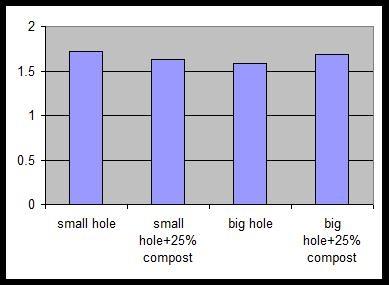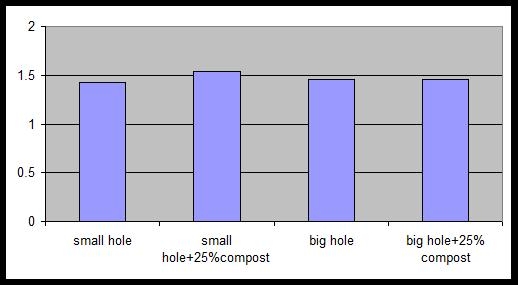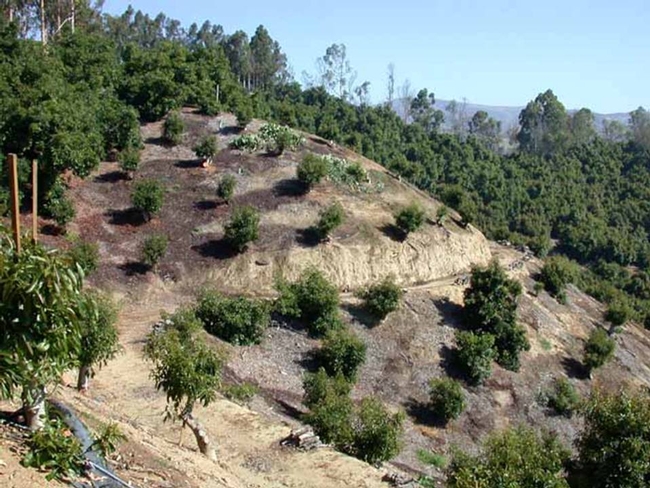Introduction
In numerous publications world-wide, planting hole recommendations for avocado and other subtropical crops are made for large holes from 2 feet by 2 by 2 to as much as a cubic yard. These recommendations also include incorporation of manures or composts comprising 25% by volume with the native soil. I have noted the use of large holes and amendments in several countries, including New Zealand, Guatemala, Brazil, Costa Rica, Mexico and the United States.
The various reasons given for making these large holes are to disrupt any compaction or limiting soil layers and to create a more conducive environment for root growth. In the case of replanting deciduous orchards, McKenry found it to be beneficial in actually replacing the native soil in the hole with pathogen free soil. In many cases, research has shown that holes much larger than the planting ball and using organic amendments can cause problems for many tree species. Improper mixing of the organic amendment can cause anaerobic conditions and settling due to amendment decomposition. Soil that has not been properly firmed in the hole can also lead to plant settling and stems can drop below grade leading to crown rot.
Nonetheless, on the basis of recommendations made in many countries there could be some value in these planting practices, especially in the light of the effect organic matter has on avocado root rot. Numerous studies have shown organic matter suppresses the causal agent of root rot. This study evaluated the effect of hole size and amendments on avocado growth in an ideal environment with excellent soil conditions and in a more harsh one with heavy soil texture and the presence of the root rot pathogen.
Materials and methods
On the north island of New Zealand in the Bay of Plenty, 20 trees each were planted to one of four treatments: a) small holes (12 by 18 inches) without amendment; b) small holes with 25% by volume compost; c) big holes (60 deep by 30 wide by 24 wide inches) without amendment and d) big holes with 25% by volume compost. Big holes were dug with a backhoe, while small holes were dug by shovel. Trees were approximately 2 feet tall at planting. Soil was a deep sandy loam at both sites. Trees were irrigated by drip irrigation. Trees were ‘Hass’ on ‘Zutano’ seedling rootstock. Trees were planted the second week of spring 2000. Tree height, trunk caliper and canopy volume were measured on a monthly basis for eight months and then twice a year for the next year. In Carpinteria, California a similar trial was established using ‘Hass’ on ‘Toro Canyon’ rootstock. Trees were approximately 2 feet tall at planting. The grove had a heavy clay loam soil and a history of root rot. The trees were on drip irrigation. The trees were planted summer 2001 and monitored for 18 months after planting.
Results and discussion
Figures 1and 2 show the results of the different planting treatments at sites in New Zealand on ideal soils and on the heavy soil infected with root rot in California. Only tree height is shown; trunk girth and canopy volume followed similar patterns. From planting onwards, there were no differences in tree growth in any of the treatments at any of the sites. This would lead one to the conclusion that there is no value in and a great expense in making big holes and incorporating amendment. This is especially so in hillside situations where moving equipment and amendments on steep slopes would be very difficult.
The trees at the Carpinteria site, although infested with root rot, all looked good. The addition of organic matter in conjunction with the clonal rootstocks did not apparently provide any greater disease resistance. This is in accordance with work done by John Menge which shows that the greatest benefit derived from mulching are seedling rootstocks. The effect of mulch on disease suppression diminishes with the rootstock’s resistance to root rot.
Figure 1. Tree height (meters) at site 1 in New Zealand 20 months after planting. No differences were found at the 5% level of significance.

Figure 2. Tree height (meters) in California 18 months after planting. No differences were found at the 5% level of significance.

